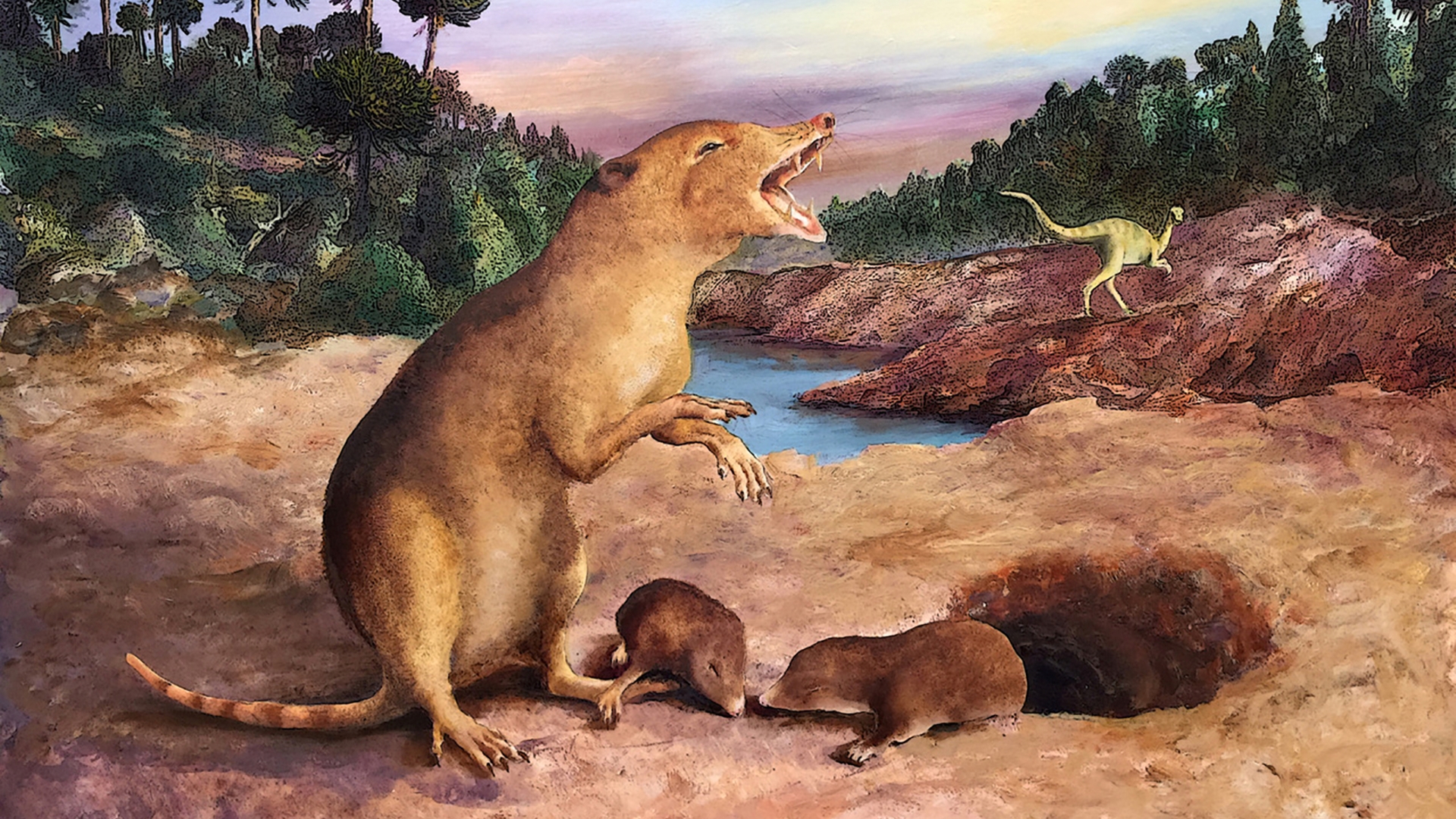Mammals lived alongside some of the earliest dinosaurs, controversial study claims
Early mammal classification is controversial.

The earliest known mammal was a tiny, shrewlike animal that lived alongside the first dinosaurs 225 million years ago, pushing back the appearance of mammals by about 20 million years, a controversial new study claims.
An international team of researchers studied the fossilized remains of an 8-inch-long (20 centimeters) animal called Brasilodon quadrangularis and decided it was a mammal because it grew two sets of teeth over its lifetime as most mammals, including modern humans, do. The authors claim that B. quadrangularis is now the earliest mammal known to science, given that it appears in the fossil record about 20 million years before Morganucodon, which was previously the earliest known animal that they consider to be a mammal.
However, early mammal classification is complex, and a researcher who was not involved in the study told Live Science that neither B. quadrangularis nor Morganucodon is a mammal and that both belong further back on the evolutionary tree despite their mammal-like dentition.
Milk-producing mammary glands — one trait that helps define mammals today — haven't been found in the fossil record, so researchers look for evidence of mammal ancestry in mineralized bones and teeth. One dental characteristic of mammals is the presence of two sets of teeth: baby teeth and adult teeth. In contrast, reptiles and fish can often regrow their teeth (if they have them) and go through multiple sets as juveniles and adults.
Related: Mammals ballooned in size after the dinosaurs went extinct. Here's how they did it.
The researchers analyzed three B. quadrangularis lower jaws — one juvenile jaw and two adult jaws — from the Linha São Luiz site in southern Brazil, where the species was first discovered decades ago alongside some of the earliest dinosaurs. The team used a destructive technique of sectioning the jaws to see the teeth developing inside them; universities in southern Brazil have lots of B. quadrangularis fossils, so the jaws weren't too precious to cut.
"What we found is that Brasilodon only changes its teeth once," co-author Martha Richter, a scientific associate at the Natural History Museum in London, told Live Science. The presence of two sets of teeth makes B. quadrangularis a diphyodont — the name given to an animal with two sets of teeth — and suggests that B. quadrangularis is more closely related to mammals than to reptiles.
Sign up for the Live Science daily newsletter now
Get the world’s most fascinating discoveries delivered straight to your inbox.
"We don't have any examples of a reptile that only has two sets of teeth," Richter said. "The old reptiles constantly changed their teeth at different rates."
Studies show that diphyodont teeth are the result of a "genetic chain of events" that regulates not just the shape of the skull and teeth but also bodily functions that are also associated with mammals, such as endothermy (the ability to metabolically regulate body heat), lactation and fur growth, Richter said. "They are all linked together," she added.
B. quadrangularis looked like a mammal, with a long tail and other shrewlike features. Positioning the species as the earliest known mammal would make it part of the evolutionary line that survived two mass extinction events, including the asteroid strike that wiped out the nonavian dinosaurs at the end of the Cretaceous period 66 million years ago and enabled mammals to diversify across land and sea. However, not everyone is convinced by the study's conclusions.
"The study presents no data to support a change in position of Brasilodon," Simone Hoffmann, an associate professor at the New York Institute of Technology who specializes in the evolutionary history of early mammals, told Live Science. "Based on all other studies, Brasilodon is not a mammal, it is certainly not the oldest mammal, and it is not even a mammaliaform (mammals and their closest relatives)."
Hoffmann noted that the study authors use "mammals" and "mammaliaforms" almost interchangeably in the study. While that used to be common practice in the scientific community, she said, these groups now should be considered separate. "Mammaliaforms are a clade that's further back on the evolutionary tree than mammals," Hoffmann said. "Mammaliaforms include the fossils leading up to mammals, as well as mammals."
Morganucodon is the earliest known mammaliaform, while B. quadrangularis is typically placed either as a sister group next to mammaliaforms on the evolutionary tree, or as a sister group to the next larger clade, mammaliamorphs, according to Hoffmann.
Diphyodont teeth are a known feature of mammaliaforms, but while finding this feature on B. quadrangularis is exciting, it doesn't necessarily mean that B. quadrangularis belongs with other mammaliaforms, Hoffmann said. Animals inherit features from their ancestors, but life is constantly evolving and changing to form new branches on the evolutionary tree.
"Feathers were once thought to be a defining feature of birds," Hoffmann said. "Now we know that feathers arose much earlier and are common in many dinosaurs. But just because T. rex is now reconstructed to have feathers does not make it a bird."
Richter acknowledged that the study's findings may be disputed, noting that the classification of these early mammal groups is controversial and that the conversation about how the earliest mammals are classified is ongoing.
"This paper will help illuminate this discussion," Richter added.
The study was published online Sept. 5 in the Journal of Anatomy.
Originally published on Live Science.

Patrick Pester is the trending news writer at Live Science. His work has appeared on other science websites, such as BBC Science Focus and Scientific American. Patrick retrained as a journalist after spending his early career working in zoos and wildlife conservation. He was awarded the Master's Excellence Scholarship to study at Cardiff University where he completed a master's degree in international journalism. He also has a second master's degree in biodiversity, evolution and conservation in action from Middlesex University London. When he isn't writing news, Patrick investigates the sale of human remains.










